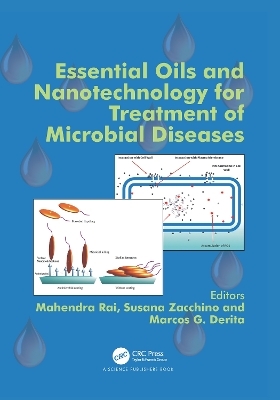
Essential Oils and Nanotechnology for Treatment of Microbial Diseases
CRC Press (Verlag)
978-0-367-78181-1 (ISBN)
There has been emergence of multidrug resistance problem all over the world due to overuse or underuse of antibiotics. Most microbes including bacteria, fungi, protozoans and others have developed resistance to antibiotics, and therefore, this problem is now recognized to be of global concern. Ubiquitous occurrence of multidrug-resistant bacteria decreases effectiveness of current treatment, which results in thousands of deaths all over the world. Hence, investigations for new alternatives and novel strategies are urgently needed to address the problem of multidrug resistance. The antimicrobial potential of essential oils and metallic nanoparticles represent an effective solution for microbial resistance. Moreover, the use of essential oils in combination with metallic nanoparticles may exert synergistic antimicrobial effects and would be a novel approach.
Essential oils (EOs) are volatile, natural, aromatic oily liquids that can be obtained from several parts of plants especially the aerial ones such as leaves and flowers. They are derived from complex metabolic pathways in order to protect plants from diverse pathogenic microorganisms. In fact, the bioactivity of EOs have been confirmed by several studies which have demonstrated their antibacterial, antiviral, anti-inflammatory, antifungal, antimutagenic, anticarcinogenic, and antioxidant properties.
Nanotechnology is one of the most important and emerging technologies, which has brought about a technological revolution in the world. It has enormous applications in the field of medicine. Nanoparticles are very important tools in curing different diseases in general and microbial diseases in particular due to their significantly novel and improved chemical, physical and biological properties and high surface area-to-volume ratio. Among these, metal nanoparticles are known to play pivotal role in various biomedical applications. In this context, nanoparticles such as silver have shown their potential and could emerge as the new generation of antimicrobials. Silver nanoparticles have broad-spectrum biological activities and hence are used in many biomedical applications. The various biomedical applications of silver nanoparticles include treatment of wounds, burns, in water-disinfecting systems, in nanobased bone implantations, in dentistry for the development of dental materials and as antibacterial, antivirals, anti-protozoals, anti-arthropods and anticancerous agents. Apart from silver, noble metal nanoparticles like gold and platinum and other nanoparticles copper, oxides of different metals, etc. have been also the materials of choice for many scientists for their biological applications.
The book will be of interest to chemists, microbiologists, biotechnologist, food technologists, nanotechnologists, pharmacologists, clinicians and those interested in nature cure. Students will find this book useful and reader friendly.
Dr. Mahendra Rai is employed in the Laboratory of Biological Chemistry, at the Institute of Chemistry, University Campinas. Professor Susana Zacchino is employed in the Pharmacognosy Area of the School of Pharmaceutical and Biochemical Sciences at the National University of Rosario. Dr. Marcos Derita is employed in the area Cultivos Intensivos, at the Facultad de Ciencias Agrarias, Universidad Nacional del Litoral and Area Farmacognosia at the Facultad de Ciencias Bioquimicas y Farmaceuticas at the Universidad Nacional de Rosario.
Essential oils for treatment of different microbial diseases. Essential oils with antimicrobial properties formulated in lipid nanoparticles – review of the state of the art. Antimicrobial activities of plant essential oils and their components against antibiotic-susceptible and antibiotic-resistant foodborne pathogens. Essential oils constituted by prop-1(2)-enylbenzene derivatives used for treatment of microbial infections. Antibacterial and anti-biofilm activities of essential oils and their components including modes of action. Role of essential oils for the cure of human pathogenic fungal infections. Essential oils against microbial resistance mechanisms, challenges and applications in drug discovery. Essential oils and nanoemulsions: Alternative tool to biofilm eradication. Nano-Ag particles and pathogenic microorganisms: Antimicrobial mechanism and its application. Nanotechnology for treatment of different microbial diseases. Nanoparticles as therapeutic agent for treatment of bacterial infections. Anti-adhesion coating with natural products: When the nanotechnology meet the antimicrobial prevention. Nanotechnologies for the delivery of water-insoluble drugs. Potential of oils in development of nanostructured lipid carriers. Essential oil-based nanomedicines against trypanosomatides. Combining inorganic antibacterial nanophases and essential oils: Recent findings and prospects. Antimicrobial activity testing. Antimicrobial activity testing techniques.
| Erscheinungsdatum | 06.04.2021 |
|---|---|
| Verlagsort | London |
| Sprache | englisch |
| Maße | 178 x 254 mm |
| Gewicht | 879 g |
| Themenwelt | Medizin / Pharmazie ► Medizinische Fachgebiete ► Mikrobiologie / Infektologie / Reisemedizin |
| Medizin / Pharmazie ► Naturheilkunde | |
| Technik | |
| ISBN-10 | 0-367-78181-6 / 0367781816 |
| ISBN-13 | 978-0-367-78181-1 / 9780367781811 |
| Zustand | Neuware |
| Haben Sie eine Frage zum Produkt? |
aus dem Bereich


